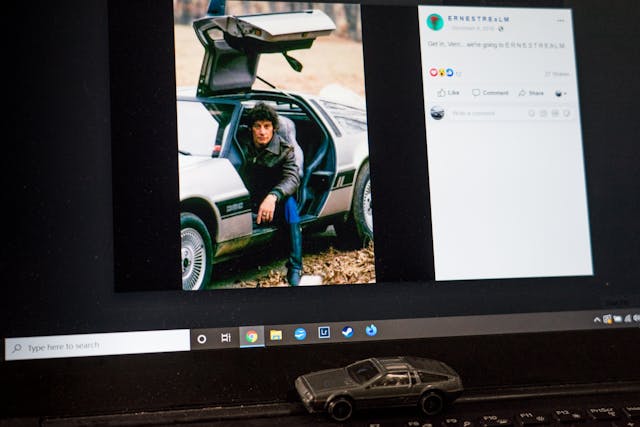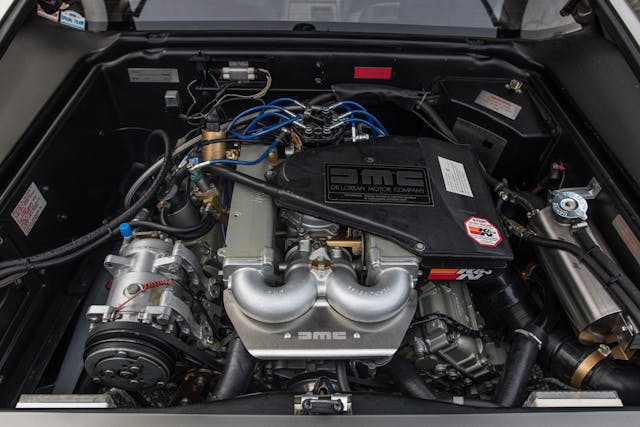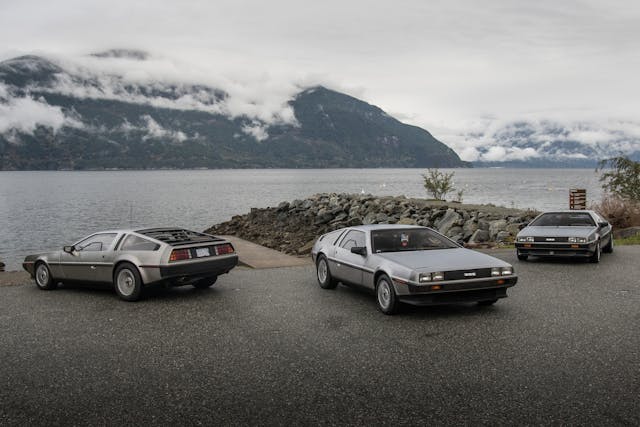“Ernest” did a lot, and he also drove a twin-turbo DeLorean
“Know what I mean, Vern?” If you’re of a certain age, you did know what Ernest P. Worrell meant. Even if your name wasn’t Vern. A staple of 1980s entertainment, Ernest bumbled across the movie screen and into our hearts, going to camp (1987), jail (1990), saving Christmas (1988), and getting scared stupid (1991). Jim Varney, who played Ernest, was a box office hit. So what did one of the biggest movie stars of the ’80s drive? That’s right, a DeLorean DMC-12. A rather special one, at that.

Mention of Varney’s DeLorean first pops up in a New York Times article on the Ernest phenomenon, dated June 1987. The author notes that Ernest Goes To Camp, the first of several feature films, banked $11M in its first two weeks, just behind Beverly Hills Cop II. Further, it’s mentioned that Varney previously appeared in a staggering 2600 commercials over the prior seven years. Varney had toiled doggedly for years, but now, thanks to Ernest, the story says, he “drives a DeLorean and lives on a sprawling farm outside of his native Nashville.”
Born in 1949, in Lexington, Kentucky, James Albert Varney showed early promise in grade school. He had an ability to memorize long passages of poetry and literature and was enrolled in drama classes by the age of eight. He would go on to become an award-winning actor, eventually trained in Shakespearean theatre. He had some success on television in the 1970s, including as a regular cast member on Johnny Cash and Friends.
Despite being a working actor, Varney needed additional funds to pay the bills. In 1980, he went to work for a Nashville advertising agency, Carden and Cherry. The first commercial featuring the character of Ernest and his signature catchphrase was for Beech Bend Park near Bowling Green, Kentucky.

Ernest became the ultimate pitchman, delivering fast-paced ads for everything from Toyota dealerships to dairies. Always speaking to camera, to the unseen “Vern,” Varney’s rubber-faced delivery grew from local popularity to national fame. He filmed thousands of spots, often for individual car dealerships rather than chains.
In 1985, Jim Varney was one of a handful of celebrity guests taking parade laps at the Indy 500. Disney executives, including Michael Eisner, were in the audience and were stunned when several hundred thousand people stood up and yelled, “Hey, Vern!” as Varney passed. The Ernest phenomenon was destined for theaters.
Critics hated Ernest, but audiences—especially kids—loved him. For Varney, it was essentially a one-note performance, one that would pigeonhole him for the rest of his life. Movie success would last just a few years, before the Ernest films would start going directly to video.
A DeLorean DMC-12 could not be a more fitting vehicle for Varney’s trajectory. The stainless-steel-bodied DeLorean was something of an Icarus, an idea full of ambition and audacity that ultimately ended in tears. The DMC-12 has a reputation for being slow, heavy, unreliable, and an eventual failure.
However, as any DeLorean fan will tell you, there’s more to the appeal of a DMC-12 than oft-quipped jokes about overheating issues and Back To The Future flux capacitors. Nothing short of an exotic turns heads like a DeLorean, and when properly set up, they’re surprisingly enjoyable to drive.

However, in-period, it’s true that the emissions-choked PRV V-6 was a bit of a slug. A DMC-12 weighs 2743 pounds, about the same as a current Toyota 86, but with only 130 hp on tap, performance was leisurely.
That wasn’t the case with the Varney DeLorean. Details on when he acquired it and when it was modified are thin. At some point, though, Varney’s DMC-12 was equipped with a twin-turbo system from Island Turbo, a shop based on Long Island in New York. At the time, the kit would have cost a staggering $5000, basically the price of a contemporary Honda Civic.
Every Island system was custom-made, and there are a few variations, but Varney’s DMC-12 would have been fitted with twin IHI turbos tuned to produce approximately 5 psi of boost, improving power to more like 200–230 hp—not much to raise eyebrows now, but a significant horsepower and torque bump at the time.
Turbochargers are a formidable way to add grunt, but for a system not designed for forced induction it can shorten the life of an engine. At some point, Varney found this out the hard way, and his DeLorean was dead. In an interview with travel writer Mark Seal, Billy Bob Thornton said, “I used to stay at Varney’s house every now and then. This was a hillbilly with money. He’s probably the only person in history who had a DeLorean up on blocks in his front yard.”

However, just as was the case with his DeLorean, there was more to Varney than met the eye. He was a skilled actor and possessed hidden talents. In an appearance on the long-defunct Chevy Chase talk show, he shrugged off Chase’s insulting banter with grace, then produced a dulcimer and played it beautifully. Ernest may have been an accident-prone goofball, but the man who played him was gentle, kind, and intelligent.
Varney died in 2000, at the age of 50. He had always been a heavy smoker and was felled by lung cancer. He never allowed himself to be photographed smoking, as he didn’t want to influence children to perhaps start. Towards the end of his life, he lent his characteristic voice to Slinky Dog in two of the beloved Toy Story animated features.
Together, Varney and his DeLorean were an unusually perfect pairing of underestimated 1980s icons—both now gone. The DMC-12 passed through several hands, and it is unknown if it ever ran again. For a time though, the coolest car on the roads around Kentucky was a turbocharged DeLorean DMC-12 with Jim Varney at the wheel. And maybe like Vern, unseen but very much along for the ride.


